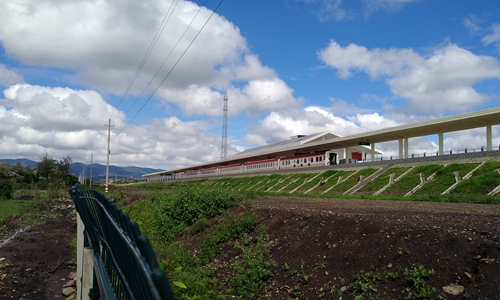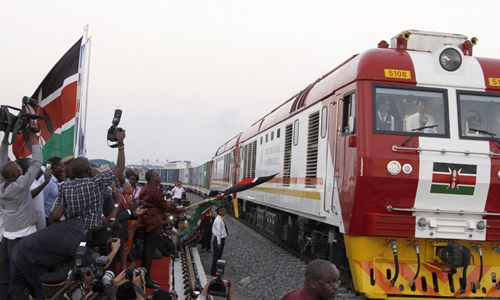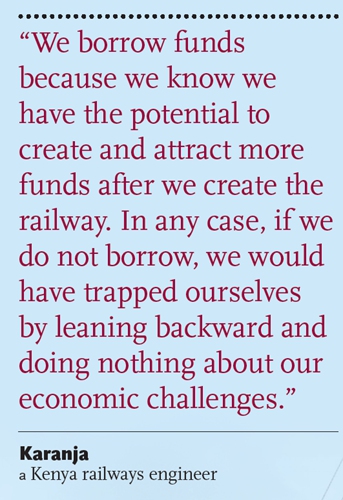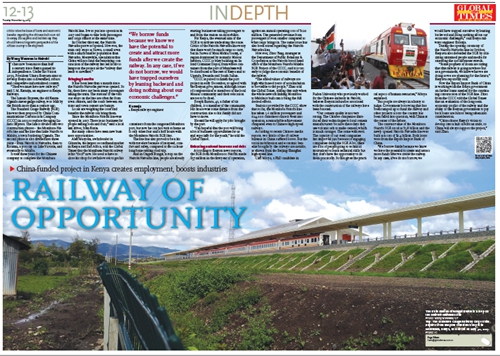IN-DEPTH / IN-DEPTH
China-funded railway in Kenya creates employment, boosts industries
Railway of opportunity
Critics raise the issue of loans and economic benefits regarding the Chinese-built SGR rail in Kenya, but experts and insiders say they should have a long-term perspective of the African country's development

It has now been more than half a century since Kenya gained its independence. Under his Vision 2030, President Uhuru Kenyatta aims to develop Kenya into a diversified, robust and competitive industrialized country.
"Then we must have new railways," said J. M. Karanja, an engineer at Kenya Railways.
The Lunatic Express, the old Kenya-Uganda meter-gauge railway, was built by the British more than a century ago.
The Standard Gauge Railway (SGR) line was then proposed by China Communications Construction Company (CCCC) in 2012 to replace the aging Lunatic Express. The line is divided into two construction phases - the Mombasa-Nairobi line and the line that links Nairobi to Malaba, a town bordering Uganda. The second phase is also divided into three parts - from Nairobi to Naivasha, then to Kisumu, a port city on Lake Victoria, and eventually to Malaba.
It took three years for the Chinese company to complete the Mombasa-Nairobi line. It was put into operation in 2017 and began to take both passengers and cargo almost at the same time.
In October this year, the Nairobi-Naivasha part was opened. However, the train only stops at Suswa, a small town with a much smaller population than Naivasha. Meanwhile, speculation that China will not fund the remaining construction of the railway has led locals to lampoon the project as the "railway that leads to nowhere."

Bringing benefits
It has been less than a month since the Nairobi-Naivasha part was opened. So far, there have not been many passengers taking the train. The stations of the various stops on the line are often far from town centers, and the roads between stations and town centers are bumpy.
Locals are weighing the costs and benefits the railway can bring them.
Since the Mombasa-Nairobi line was opened in 2017, there is no business for people selling soda and fruit, said a local taxi driver, John Kuria.
But many others have seen new business opportunities.
Alex Musyoka, a wholesaler in Gikomba, the largest secondhand market in Kenya and East Africa, told the Global Times that the Mombasa-Nairobi railway is his "food" now. He used to have to close his shop for a whole week to get his containers from the congested Mombasa port, but now he can just wait at home as it only takes four and a half hours with the Mombasa-Nairobi SGR line.
The line has also proved to be a hit with travelers because of its speed, comfort and safety, compared to the 12-hour-long bone-rattling road trip.
And in Ongata Rongai, a stop on the Nairobi-Naivasha line, people are already starting businesses taking passengers to and from the station on motorbikes.
For Kenya, the eventual aim of the SGR is to activate trade along the route. Critics of the Nairobi-Naivasha line worry that there won't be much cargo to carry, but in Suswa of Maai Mahiu county, a region dominated by nomadic Maasai herders, CCCC is busy building an Inland Container Depot, from where containers from the port of Mombasa will be distributed to the rest of Kenya and to Uganda, Rwanda and South Sudan.
CCCC is poised to finish the port project in early December, as agreed with the Kenyan government, although issues of compensation to members of the local Maasai community and their relocation are yet to be fixed.
Joseph Kuraru, 41, a father of six children, is a member of the community. His house was some distance from the construction site so his family did not have to move.
He said he will apply for jobs brought by the port.
"I'm hopeful that the port will bring a lot of business opportunities for us and especially for the youth," he told the Global Times.

Attracting more funds
According to Kenyan news reports, the SGR from Mombasa to Nairobi made $57 million in the first year of operation, against an annual operating cost of $120 million. The generated revenue from passengers is even smaller compared to what cargo brings in. The same issue has also been raised regarding the Nairobi-Naivasha line.
However, Zhao Yang, manager at the Department of Public Relations & Cooperation at the Nairobi-based head office of the Mombasa-Nairobi-Malaba SGR Project of the CCCC, said it is too early to judge the economic benefits of the railway.
"The added values of railways are high which need years of accumulation to be visible to the people," Zhao told the Global Times, adding that only when the whole network linking Mombasa to Malaba is built can it bring the full desired effects.
Statistics provided by the CCCC show that so far, the Mombasa-Nairobi line has taken 3.6 million passengers and 624,000 containers since it went into operation, a remarkable achievement compared even to Chinese high-speed railways.
According to recent Chinese media reports, two thirds of the 18 railway bureaus in China suffered losses. But the social mobilization and economic benefits brought by the railways are notable, as shown from the Beijing-Shanghai high-speed line.
Cliff Mboya, a PhD candidate in Fudan University who previously worked for the Chinese embassy in Nairobi, believes Kenyan industries associated with the construction of the railways have been boosted.
"Our cement quality is not very strong. The Chinese companies introduced their technologies to local cement manufacturers because these days they use volcanic ash to make cement, which is much stronger. The same with steel. The capacity of our steel companies has improved just because of engaging companies doing the SGR. Also, there are a lot of people going to technical institutions to learn technical skills but they don't have the opportunity to do them practically. So that gives the practical aspect of human resources," Mboya explained.
But people are always in a hurry to judge. Government borrowing that has been ramped up to fund the railway and other projects across the country has been called into question, with China at the center of the debate.
The contract value of the Mombasa-Nairobi SGR stood at $3.8 billion and the newly opened Nairobi-Naivasha line was built at a cost of $1.4 billion. Both loans were from the Export-Import Bank of China.
"We borrow funds because we know we have the potential to create and attract more funds after we create the railway. In any case, if we do not borrow, we would have trapped ourselves by leaning backward and doing nothing about our economic challenges," said Kenya railways engineer Karanja.
During the opening ceremony of the Nairobi-Naivasha line in October, Kenyatta also defended the SGR by criticizing unnamed people and media for smearing the 120-kilometer stretch.
"Some prophets of doom are saying that this railway is going nowhere but as a government, we know what we are doing as we are planning for the future," Kenyatta reportedly said.
Now the Export-Import Bank of China is working with the Kenya government on further loans needed for the continuing construction of the SGR line. Zhao from the CCCC told the Global Times that an evaluation of the long-term economic profits of the railway and the ability of the Kenyan government to pay back loans are factors being taken into consideration.
"China shares Kenya's vision to develop into a hub of African trade, so China will always support the project," said Zhao.
This work was produced as a result of a grant provided by the Africa-China Reporting Project at the Journalism Department of the University of the Witwatersrand.


The train station of Rongai which is a stop on the Nairobi-Naivasha line Photo: Wang Wenwen/GT
It has now been more than half a century since Kenya gained its independence. Under his Vision 2030, President Uhuru Kenyatta aims to develop Kenya into a diversified, robust and competitive industrialized country.
"Then we must have new railways," said J. M. Karanja, an engineer at Kenya Railways.
The Lunatic Express, the old Kenya-Uganda meter-gauge railway, was built by the British more than a century ago.
The Standard Gauge Railway (SGR) line was then proposed by China Communications Construction Company (CCCC) in 2012 to replace the aging Lunatic Express. The line is divided into two construction phases - the Mombasa-Nairobi line and the line that links Nairobi to Malaba, a town bordering Uganda. The second phase is also divided into three parts - from Nairobi to Naivasha, then to Kisumu, a port city on Lake Victoria, and eventually to Malaba.
It took three years for the Chinese company to complete the Mombasa-Nairobi line. It was put into operation in 2017 and began to take both passengers and cargo almost at the same time.
In October this year, the Nairobi-Naivasha part was opened. However, the train only stops at Suswa, a small town with a much smaller population than Naivasha. Meanwhile, speculation that China will not fund the remaining construction of the railway has led locals to lampoon the project as the "railway that leads to nowhere."

Top: The Standard Gauge Railway cargo train rides from the port containers depot in Mombasa, Kenya, to Nairobi on May 30, 2017. Photo: IC
Bringing benefits
It has been less than a month since the Nairobi-Naivasha part was opened. So far, there have not been many passengers taking the train. The stations of the various stops on the line are often far from town centers, and the roads between stations and town centers are bumpy.
Locals are weighing the costs and benefits the railway can bring them.
Since the Mombasa-Nairobi line was opened in 2017, there is no business for people selling soda and fruit, said a local taxi driver, John Kuria.
But many others have seen new business opportunities.
Alex Musyoka, a wholesaler in Gikomba, the largest secondhand market in Kenya and East Africa, told the Global Times that the Mombasa-Nairobi railway is his "food" now. He used to have to close his shop for a whole week to get his containers from the congested Mombasa port, but now he can just wait at home as it only takes four and a half hours with the Mombasa-Nairobi SGR line.
The line has also proved to be a hit with travelers because of its speed, comfort and safety, compared to the 12-hour-long bone-rattling road trip.
And in Ongata Rongai, a stop on the Nairobi-Naivasha line, people are already starting businesses taking passengers to and from the station on motorbikes.
For Kenya, the eventual aim of the SGR is to activate trade along the route. Critics of the Nairobi-Naivasha line worry that there won't be much cargo to carry, but in Suswa of Maai Mahiu county, a region dominated by nomadic Maasai herders, CCCC is busy building an Inland Container Depot, from where containers from the port of Mombasa will be distributed to the rest of Kenya and to Uganda, Rwanda and South Sudan.
CCCC is poised to finish the port project in early December, as agreed with the Kenyan government, although issues of compensation to members of the local Maasai community and their relocation are yet to be fixed.
Joseph Kuraru, 41, a father of six children, is a member of the community. His house was some distance from the construction site so his family did not have to move.
He said he will apply for jobs brought by the port.
"I'm hopeful that the port will bring a lot of business opportunities for us and especially for the youth," he told the Global Times.

Attracting more funds
According to Kenyan news reports, the SGR from Mombasa to Nairobi made $57 million in the first year of operation, against an annual operating cost of $120 million. The generated revenue from passengers is even smaller compared to what cargo brings in. The same issue has also been raised regarding the Nairobi-Naivasha line.
However, Zhao Yang, manager at the Department of Public Relations & Cooperation at the Nairobi-based head office of the Mombasa-Nairobi-Malaba SGR Project of the CCCC, said it is too early to judge the economic benefits of the railway.
"The added values of railways are high which need years of accumulation to be visible to the people," Zhao told the Global Times, adding that only when the whole network linking Mombasa to Malaba is built can it bring the full desired effects.
Statistics provided by the CCCC show that so far, the Mombasa-Nairobi line has taken 3.6 million passengers and 624,000 containers since it went into operation, a remarkable achievement compared even to Chinese high-speed railways.
According to recent Chinese media reports, two thirds of the 18 railway bureaus in China suffered losses. But the social mobilization and economic benefits brought by the railways are notable, as shown from the Beijing-Shanghai high-speed line.
Cliff Mboya, a PhD candidate in Fudan University who previously worked for the Chinese embassy in Nairobi, believes Kenyan industries associated with the construction of the railways have been boosted.
"Our cement quality is not very strong. The Chinese companies introduced their technologies to local cement manufacturers because these days they use volcanic ash to make cement, which is much stronger. The same with steel. The capacity of our steel companies has improved just because of engaging companies doing the SGR. Also, there are a lot of people going to technical institutions to learn technical skills but they don't have the opportunity to do them practically. So that gives the practical aspect of human resources," Mboya explained.
But people are always in a hurry to judge. Government borrowing that has been ramped up to fund the railway and other projects across the country has been called into question, with China at the center of the debate.
The contract value of the Mombasa-Nairobi SGR stood at $3.8 billion and the newly opened Nairobi-Naivasha line was built at a cost of $1.4 billion. Both loans were from the Export-Import Bank of China.
"We borrow funds because we know we have the potential to create and attract more funds after we create the railway. In any case, if we do not borrow, we would have trapped ourselves by leaning backward and doing nothing about our economic challenges," said Kenya railways engineer Karanja.
During the opening ceremony of the Nairobi-Naivasha line in October, Kenyatta also defended the SGR by criticizing unnamed people and media for smearing the 120-kilometer stretch.
"Some prophets of doom are saying that this railway is going nowhere but as a government, we know what we are doing as we are planning for the future," Kenyatta reportedly said.
Now the Export-Import Bank of China is working with the Kenya government on further loans needed for the continuing construction of the SGR line. Zhao from the CCCC told the Global Times that an evaluation of the long-term economic profits of the railway and the ability of the Kenyan government to pay back loans are factors being taken into consideration.
"China shares Kenya's vision to develop into a hub of African trade, so China will always support the project," said Zhao.
This work was produced as a result of a grant provided by the Africa-China Reporting Project at the Journalism Department of the University of the Witwatersrand.


